La broderie de produits pour chapeaux peut transformer de simples chapeaux et casquettes en superbes, Articles personnalisés. Whether you’;Vous êtes un débutant cherchant à explorer les techniques de base de broderie de couvre-chefs ou un brodeur expérimenté souhaitant maîtriser les méthodes avancées..
Ce guide vous guidera à travers les compétences essentielles nécessaires pour créer des designs de qualité professionnelle sur divers couvre-chefs..
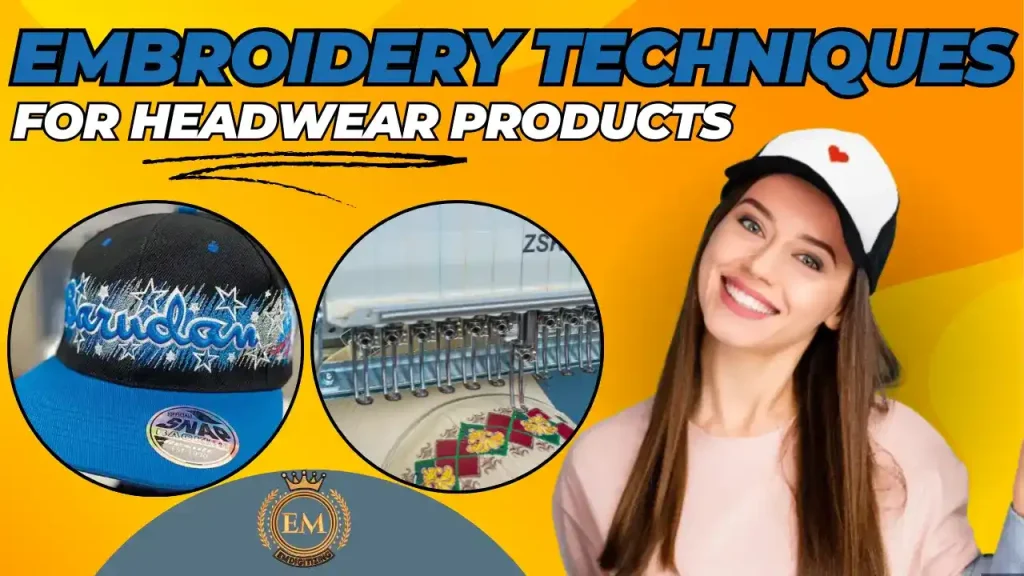
Techniques de broderie pour les produits de chapellerie: Des bases à l'avancé
Sélection du couvre-chef idéal pour la broderie
La première étape de la broderie consiste à choisir le bon couvre-chef. Chaque type a ses propriétés uniques qui peuvent améliorer vos résultats de broderie:
- Bonnet: Fabriqué à partir de tissu tricoté, les bonnets sont doux et flexibles, ce qui les rend idéaux pour les conceptions qui nécessitent une extensibilité. Ils fonctionnent mieux avec des caractères gras, simplistic designs that highlight the fabric’;la texture.
- Snapbacks: Connu pour son devant rigide et son bouton-pression réglable à l'arrière, les snapbacks offrent un appartement, surface stable pour des designs complexes et sont très populaires dans la mode urbaine.
- Casquettes de baseball: Ces casquettes sont un choix classique pour la broderie, doté d'un panneau avant lisse parfait pour les logos et les motifs détaillés qui nécessitent un placement précis des points.
- Chapeaux de seau: Avec leur bord tout autour, les chapeaux bob offrent plus de surface pour mettre en valeur des designs créatifs sur la couronne et le bord., ce qui les rend polyvalents pour des looks décontractés et élégants.
- Chapeaux de camionneur: Caractérisé par leur dos en mesh et leur panneau avant solide, les chapeaux de camionneur sont excellents pour les audacieux, des designs vibrants qui se démarquent.
- Visières: Les visières sont les plus faciles à broder en raison de leur large zone avant ouverte sur le dessus., idéal pour les logos ou les messages promotionnels.
Techniques fondamentales de broderie de couvre-chefs
Pour commencer, vous devez comprendre ces techniques fondamentales:
- Broderie à plat
- Lettrage sur les couvre-chefs
- Applique Technique
1. Broderie à plat
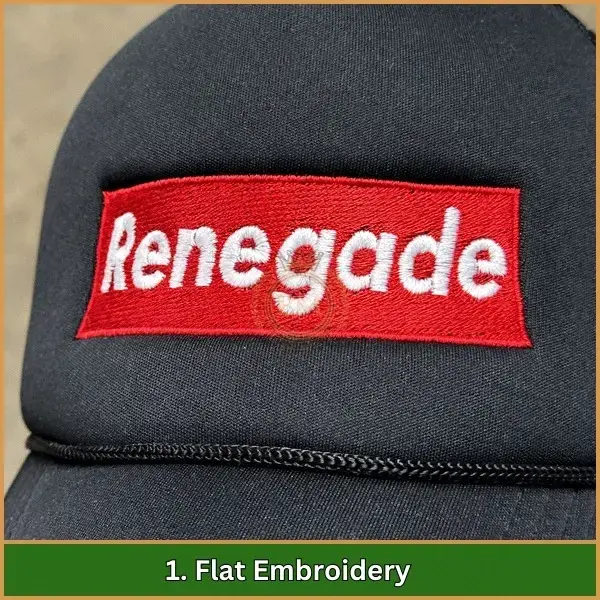
La broderie à plat est une méthode dans laquelle les motifs sont cousus directement sur le tissu du chapeau., créant une surface brodée plate et lisse.
Il est largement utilisé pour les logos, texte, et des conceptions graphiques de base sur les produits de chapellerie.
Avantages:
- Polyvalent: Convient à une large gamme de modèles, des simples logos aux graphiques détaillés.
- Finition professionnelle: Produit propre, des designs soignés qui semblent professionnels et raffinés.
- Durabilité: La broderie à plat résiste bien dans le temps, surtout sur les couvre-chefs fréquemment portés comme les casquettes.
Principales caractéristiques:
- Types de points: Les types de points courants dans la broderie à plat incluent les points satin pour des bordures lisses, points de remplissage pour couvrir de plus grandes zones, et des points courants pour des lignes ou des contours détaillés.
- Flexibilité de conception: Cela fonctionne bien avec les conceptions simples et complexes, bien que les conceptions doivent être correctement numérisées pour garantir les meilleurs résultats.
- Compatibilité des tissus: La broderie à plat peut être réalisée sur une variété de tissus, y compris le coton, polyester, et mélanges. Il est important d’adapter le type d’aiguille et de fil au tissu pour éviter de l’abîmer.
- Précision: La broderie à plat nécessite une numérisation précise du motif pour garantir que les points sont propres et correctement placés.
2. Lettrage sur les couvre-chefs
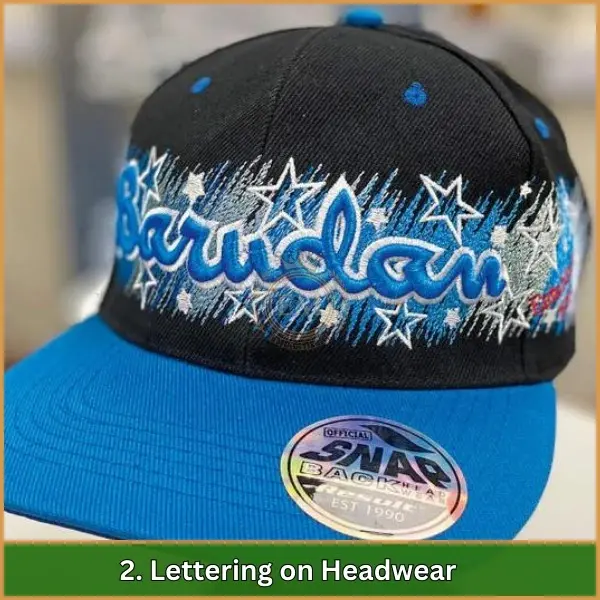
Le lettrage consiste à broder du texte sur des chapeaux, ce qui en fait l'une des techniques les plus populaires pour personnaliser les produits de chapellerie.
Qu'il s'agisse d'ajouter un nom, un slogan de marque, ou un logo, le lettrage apporte une touche personnelle et professionnelle aux casquettes et chapeaux.
Avantages:
- Personnalisation: Parfait pour les commandes personnalisées comme les monogrammes, image de marque, ou des objets promotionnels.
- Polyvalence: Fonctionne bien sur différents types de chapeaux, des casquettes de baseball aux bonnets.
- Opportunités de marque: Le lettrage sur les couvre-chefs est un excellent moyen de mettre en valeur les noms d'entreprise ou les logos d'équipe..
Principales caractéristiques:
- Sélection de police: Choisissez clair, des polices lisibles adaptées à la taille du couvre-chef. Les polices sans empattement sont souvent idéales pour les textes petits ou denses.
- Type de point: Les points satin sont le plus souvent utilisés pour le lettrage car ils créent un effet lisse., aspect poli. Ils apportent également de la clarté, surtout lorsque vous utilisez des polices grasses.
- Mise à l'échelle: Des lettres correctement mises à l'échelle garantissent qu'elles ne sont pas trop petites ou déformées, surtout sur les surfaces courbes comme les capuchons.
3. Applique Technique
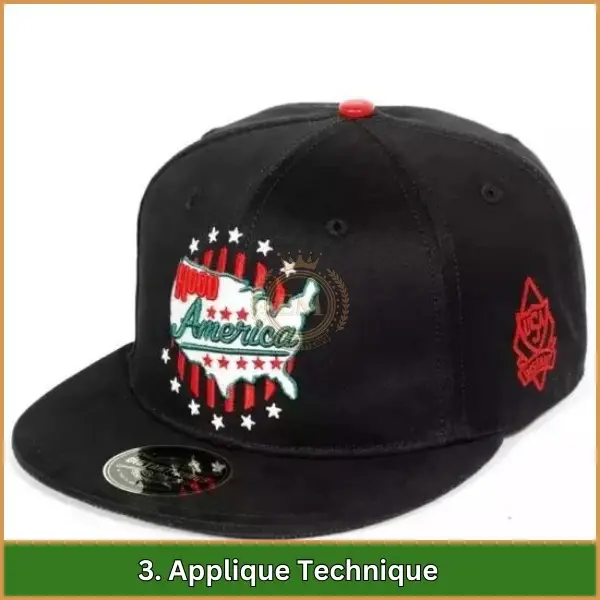
L'applique consiste à coudre un morceau de tissu sur le tissu de base du chapeau..
Cela ajoute de la profondeur, texture, et contraste avec le design, ce qui en fait un favori pour les plus grands, des motifs plus audacieux.
Avantages:
- Impact visuel: Crée un design plus dynamique et visuellement intéressant en superposant différents tissus.
- Texture et contraste: L'ajout de couches de tissu peut apporter un contraste de texture et de couleur, faire ressortir les designs.
- Efficacité du temps: L'applique peut couvrir de plus grandes zones avec moins de coutures par rapport aux motifs entièrement brodés., gagner du temps.
Principales caractéristiques:
- Sélection de tissus: Choisissez des tissus comme le feutre, coton, ou satin qui offrent un contraste avec la matière du chapeau. Le tissu doit être facile à couper et à manipuler.
- Piqûre: Les bords de l'applique sont généralement finis avec un point zigzag ou satiné., s'assurer que le tissu est solidement fixé et que le motif est propre, arêtes vives.
- Durabilité: L'applique ajoute une couche supplémentaire de tissu, offrant de la durabilité à la section brodée tout en créant du gras, dessins colorés.
Techniques intermédiaires pour améliorer les détails des couvre-chefs
Once you’;êtes à l’aise avec les compétences de base, ces techniques intermédiaires peuvent ajouter du style à vos projets:
- Dentelle autoportante
- Techniques de monogramme
- 3D Puff Broderie
1. Dentelle autoportante
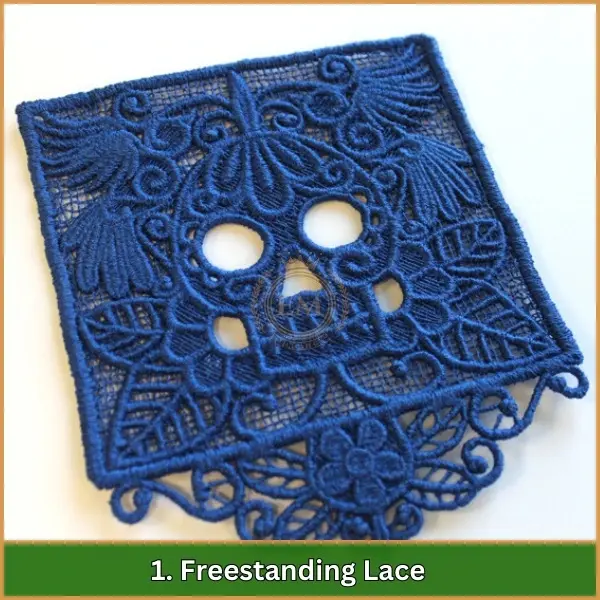
La dentelle autoportante est délicate technique de broderie où les motifs de dentelle sont cousus sur un stabilisateur soluble dans l'eau. Une fois la couture terminée, le stabilisateur est emporté, laissant derrière lui un motif de dentelle magnifiquement brodé.
Avantages:
- Conception élégante: Idéal pour ajouter des éléments complexes, éléments décoratifs pour produits de chapellerie, especially for women’;s chapeaux ou accessoires de mariée.
- Utilisation polyvalente: Peut être appliqué sur différentes parties du chapeau, comme le bord ou la couronne, ajoutant une touche unique au design global.
- Aucune base en tissu requise: Crée une structure de dentelle autonome qui n'a pas besoin d'être cousue sur un autre tissu.
Principales caractéristiques:
- Stabilisateur soluble dans l'eau: Le stabilisant se dissout dans l'eau, permettant à la dentelle de tenir debout toute seule.
- Modèles complexes: La dentelle autoportante fonctionne bien avec des, floral, ou des motifs décoratifs, parfait pour ajouter une touche élégante à un couvre-chef.
- Application: La dentelle peut être utilisée comme accents ou embellissements, ce qui en fait un choix polyvalent pour améliorer le design.
2. Techniques de monogramme
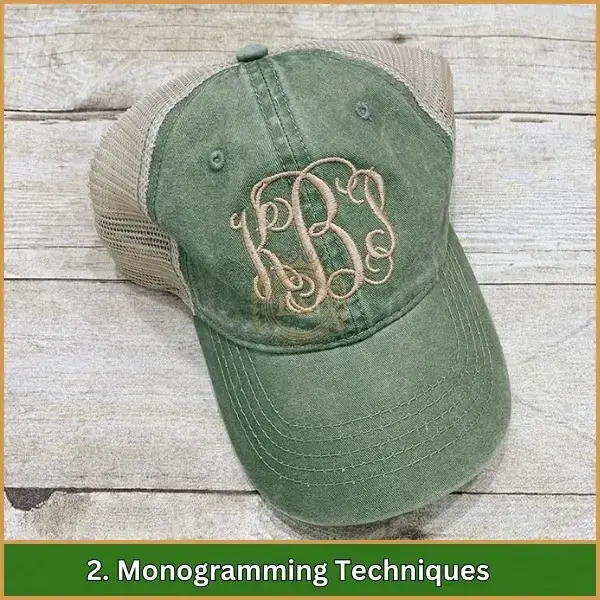
Le monogramme consiste à broder des initiales ou des noms complets sur des chapeaux, offrir une touche personnalisée aux couvre-chefs. Des scripts élégants aux lettres majuscules modernes, le monogramme ajoute un élément élégant et personnalisé à n'importe quel design..
Avantages:
- Personnalisation: Idéal pour les commandes personnalisées, donner au chapeau un caractère unique, sensation personnelle.
- Variété de styles: Le monogramme offre une gamme de styles de police, du classique et formel au moderne et décontracté, vous permettant d'adapter le design aux préférences du client.
- Utilisation polyvalente: Fonctionne bien sur tous les types de couvre-chefs, y compris les bouchons, bonnets, et visières.
Principales caractéristiques:
- Variété de polices: Vous pouvez choisir parmi une large sélection de polices, selon le style que vous souhaitez obtenir.
- Taille et emplacement: Une taille et un positionnement appropriés des initiales sont essentiels pour garantir qu'elles soient proportionnées et élégantes sur le chapeau..
- Personnalisation: Le monogramme permet des cadeaux personnalisés ou la promotion de la marque, ce qui le rend très populaire pour les commandes d'entreprises et individuelles.
3. 3D Puff Broderie
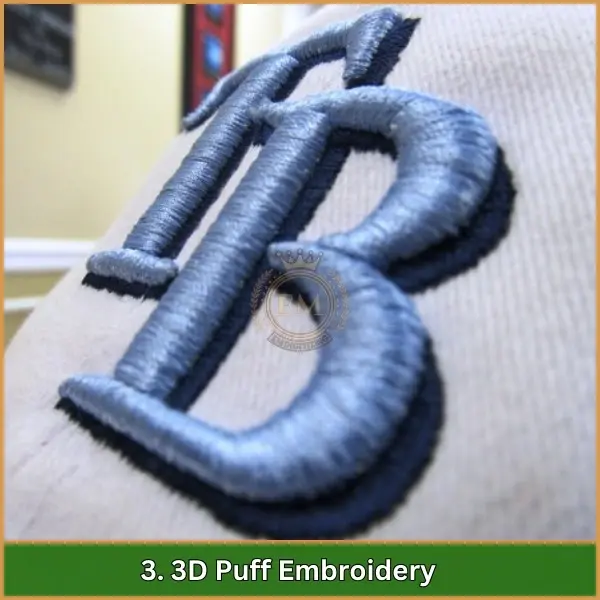
3La broderie feuilletée D est une méthode dans laquelle de la mousse est placée sous la zone de couture avant de broder..
Cette mousse soulève les coutures de la surface, créer un audacieux, effet tridimensionnel.
Avantages:
- Impact visuel saisissant: Le design surélevé donne un aspect audacieux, effet accrocheur, ce qui en fait un favori pour les casquettes de sport et les articles promotionnels.
- Durabilité: La mousse offre un soutien supplémentaire aux coutures, rendant le motif brodé plus durable et résistant à l'usure.
- Texture: Ajoute un élément tactile au design, ce qui le rend non seulement visuellement attrayant mais aussi intéressant au toucher.
Principales caractéristiques:
- Base en mousse: La mousse est placée sous le motif avant la couture, créer un aspect tridimensionnel.
- Densité de point: La densité des points doit être ajustée pour garantir que la mousse est entièrement recouverte et que le motif semble lisse et uniforme..
- Adéquation de la conception: 3Broderie bouffante D fonctionne mieux avec simple, dessins audacieux, tels que des logos ou des textes volumineux, car des détails complexes peuvent être perdus dans l'effet en relief.
Compétences avancées en broderie pour la broderie de couvre-chefs
Pour ceux qui veulent repousser les limites de leurs compétences en broderie, ces techniques avancées méritent d'être explorées:
- Point de croix sur les machines
- Broderie au point photo
- Broderie dans le cerceau
1. Point de croix sur les machines
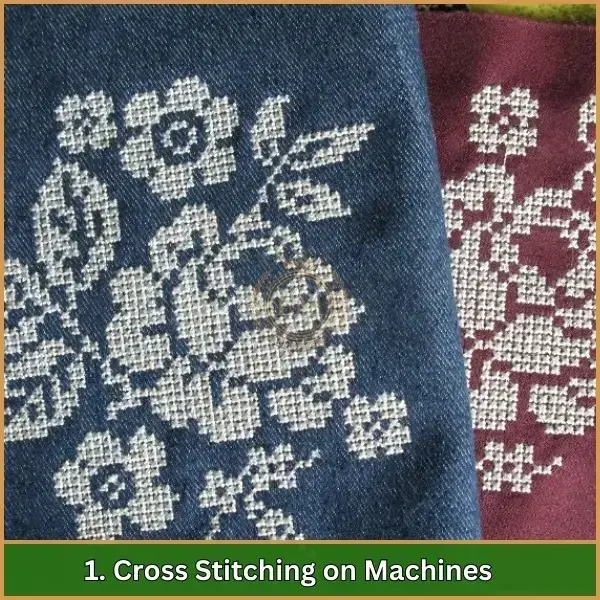
Point de croix, traditionnellement un broderie à la main méthode, peut être adapté aux machines pour créer des designs avec un caractère unique, aspect texturé. It involves making “;X”;-points de forme, donnant un look traditionnel mais élégant.
Avantages:
- Aspect texturé: The “;X”; les points donnent au design une touche distincte, texture cousue à la main, idéal pour ajouter de la profondeur et de la complexité.
- Aspect traditionnel: Cela apporte un classique, ambiance vintage au design, ce qui le distingue des autres styles de broderie.
- Polyvalence: Convient aux motifs simples et complexes, permettant un large éventail de possibilités de conception.
Principales caractéristiques:
- Modèles de point de croix: La machine imite le point de croix à la main, créer un look artisanal.
- Jeu de couleurs: Multiple couleurs de fil peut être utilisé pour créer des, motifs complexes.
- Variété de conception: Des formes géométriques simples aux formes complexes, dessins détaillés, le point de croix offre une grande polyvalence.
2. Broderie au point photo
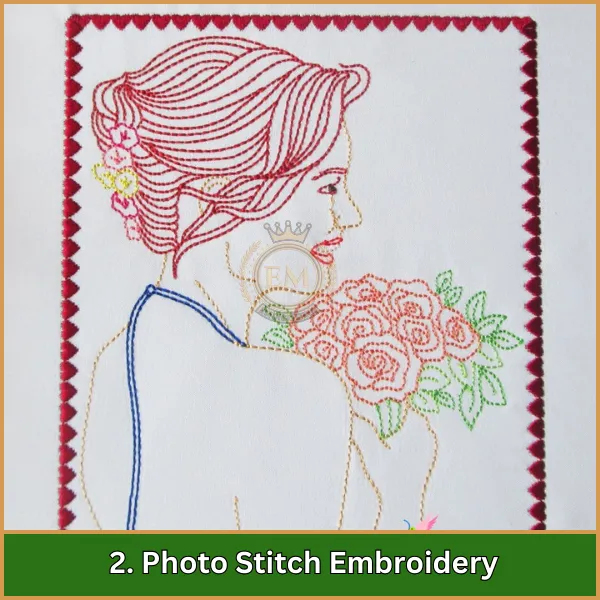
La broderie au point photo transforme les images haute résolution en motifs de points détaillés. Cette technique vous permet de broder des portraits réalistes ou des images détaillées sur des chapeaux, créer un effet photoréaliste.
Avantages:
- Détails élevés: Capture des détails complexes et des dégradés de couleurs, ce qui le rend parfait pour recréer des photos, logos, ou des designs réalistes.
- Conceptions personnalisées: Idéal pour personnaliser des produits de coiffure avec des photos, logos détaillés, ou une œuvre d'art personnalisée.
- Apparence professionnelle: Le point photo donne une finition artistique et professionnelle, surtout pour les commandes personnalisées.
Principales caractéristiques:
- Conversion d'images: Les images haute résolution sont converties en fichiers de points numérisés, qui sont ensuite brodés sur le tissu.
- Complexité de couture: La technique nécessite des niveaux élevés de précision et de contrôle de la machine, car le dessin est souvent composé de milliers de petits points.
- Exécutions de tests: Des tests sur un tissu similaire sont recommandés pour garantir que le motif se traduit bien sur le chapeau et que les couleurs apparaissent avec précision..
3. Broderie dans le cerceau
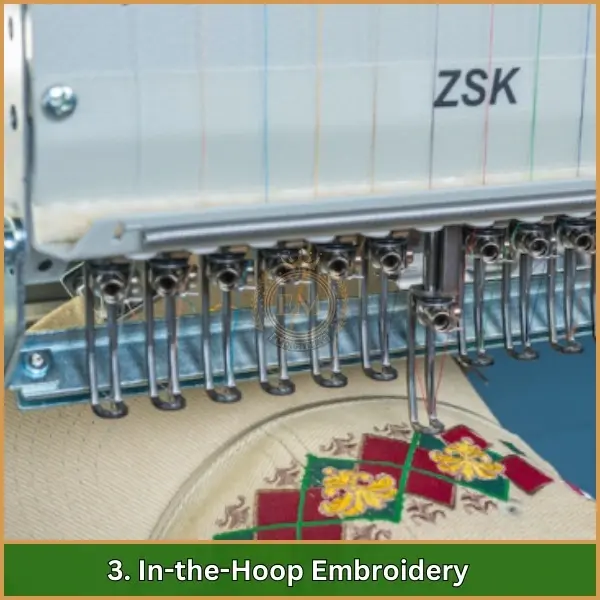
Dans le-broderie au cerceau est une technique où des projets entiers sont réalisés dans le cercle à broder, combiner plusieurs étapes telles que la couture, coupe, et même en ajoutant des éléments fonctionnels comme des fermetures éclair.
Avantages:
- Précision: Maintient le tissu stable dans le cerceau, s'assurer que les motifs sont brodés avec précision et cohérence.
- Multifonctionnel: Permet la création de projets complexes qui vont au-delà de la simple broderie, comme l'ajout de poches, fermetures à glissière, or appliques.
- Efficacité: Combine plusieurs étapes en un seul projet, réduisant le besoin de touches de finition supplémentaires une fois la broderie terminée.
Principales caractéristiques:
- Coutures contrôlées: Le tissu reste stable dans le cercle, permettant une couture précise et un risque réduit d'erreurs.
- Polyvalence du projet: Les projets in-the-cerceau peuvent inclure des éléments fonctionnels ou décoratifs, ce qui le rend approprié pour créer plus que de simples motifs brodés.
- Planification détaillée: Cela nécessite une planification minutieuse et une numérisation de la broderie., car l'ensemble du projet doit être réalisé dans les limites du cercle à broder.
Conseils professionnels pour des résultats exceptionnels
Assurez-vous que votre broderie se démarque grâce à ces conseils d'experts.
- Choisir les bons matériaux: Investissez dans des fils et des stabilisateurs de haute qualité qui complètent le type de tissu de votre couvre-chef.
- Numérisation et tests de conception: Numérisez avec précision vos motifs et effectuez des tests sur des tissus similaires pour éviter les problèmes lors de la broderie finale.
- Entretien des équipements: Entretenez régulièrement votre Machine à broder pour garantir une qualité constante et prévenir les pannes mécaniques.
Conclusion
Broder des couvre-chefs est un excellent moyen de créer des designs uniques et personnalisés.. Que vous débutiez ou que vous travailliez avec des techniques avancées, vous pouvez créer des couvre-chefs d'aspect professionnel avec les bonnes compétences.
De la broderie basique à la broderie avancée, la pratique vous aidera à vous améliorer et à faire ressortir vos projets.
Si vous souhaitez gagner du temps et obtenir des motifs parfaitement numérisés pour votre broderie, EMnumérisation est là pour aider. Notre équipe d'experts peut transformer vos idées en motifs de broderie prêts à l'emploi..
Plus, nous offrons un 50% réduction pour tous les nouveaux clients! Laissez EMdigitizing gérer le travail technique afin que vous puissiez vous concentrer sur votre créativité.
Essayez EMdigitizing aujourd'hui et voyez comment nous pouvons rendre votre projets de broderie plus facile et meilleur!
FAQ
Oui, les chapeaux et les casquettes entrent dans la catégorie des couvre-chefs et des accessoires de chapellerie. La principale différence est que les chapeaux ont toujours un bord et une couronne en forme., alors que les casquettes sont moins structurées, il manque un bord, mais comportent toujours une visière ou une visière.
Couvre-chef, couvre-chef, ou coiffe fait référence à tout vêtement porté sur la tête, y compris les chapeaux, casques, turbans, et d'autres types. Ces articles peuvent être portés pour la protection, décoration, raisons religieuses ou culturelles, ou pour suivre les coutumes sociales.
- Lavez-vous toujours les mains avant de commencer un projet de broderie.
- Assurez-vous que les bords de la toile sont bien fixés pour éviter l'effilochage..
- Commencez à broder à partir du centre du motif.
- Utilisez un marqueur spécifique au tissu pour créer une grille de 10/10 cellules pour guider votre couture.
